Ninety per cent. That’s the shocking percentage of homes that can be lost or damaged in a wildfire started by a stray ember. It’s an important number to remember as we head into wildfire season.

As of May 2024, wildfire season has already begun in BC. That’s why FireSmart BC’s new campaign titled “Our Part, Your Part” is timely in sending the message that while first responders will do their part to battle wildfire blazes, residents also have an important role in wildfire prevention and mitigation.
“During a wildfire response, first responders protect residents, but they’re also involved in the preparedness aspect of wildfire response. This includes informing and educating the public about how they can prepare for wildfire,” says Hannah Swift, FireSmart BC Program Lead and BC FireSmart Committee Chair.
“Over the years we’ve seen an increase in the intensity and number of wildfires in the province,” says Swift. “This isn’t a problem that can be tackled by one person or organization. When everyone does their part, it can make a big difference in reducing community wildfire risk.”
For residents, this might mean having an evacuation plan ready if necessary. You can also prepare your home and property to mitigate wildfire potential and damage. The best place to start is with a home assessment to determine how vulnerable your home and property are.
Here are five easy things you do right away:
1. Move combustibles: “Start with a clean up around your home and make sure there are no combustibles within 10 metres of your property,” says Swift. “Look around the property and move things like stacks of firewood and plastic yard toys away from the home. That way if there is a stray ember, it won’t light up and spark your home.” Combustibles also include things such as construction materials in your driveway, propane tanks, patio furniture, recreational vehicles, and more.
2. Get to your gutters and roofs: Now is the time to clear out your gutters, eaves and vents given dry leaves, pine needles and other debris are a fire hazard–especially during high fire season. Should one of those stray embers land on a cluttered gutter, that gives the fire a route to travel.
3. Look at your landscaping:We can also make sure our lawns are cut below 10 centimetres. “Wildfire loves tall grass,” says Dan Stevens, FireSmart Education & Outreach Coordinator for the First Nations’ Emergency Services Society of BC. Replace cedar hedges (and cedar chips), which are quite flammable, with more fire-resistant plants such as Poplar Birch to help try and ward off potential flames. Also, prune trees so there’s a two-metre clearance from the ground to avoid creating a “ladder” which helps fire go from an ember landing nearby to climbing up to the treetops. FireSmart BC has a landscaping hub to help make your property more fire resilient.
4. Use mesh: “Cover your exterior vents with three-millimetre metal mesh but don’t cover your dryer vent,” says Stevens. Vents are open spots for embers to enter your home so 3mm is the best size to keep embers out but to avoid clogging.
5. Survey your other structures: Have a shed in your backyard or a pool house? All these rules apply to those structures as they do to your home.
FireSmart BC is actively educating communities across British Columbia on wildfire preparedness, prevention, and mitigation efforts. Through their partnership with the First Nations Emergency Services Society of British Columbia (FNESS), they also bring FireSmart resources and information to Indigenous communities.
FNESS collaborates closely with First Nations to enhance safety through comprehensive programs, aiding communities in accessing funding opportunities. For instance, the FNESS-Indigenous Services Canada (ISC) On-reserve FireSmart Program allows First Nation communities to apply for grants up to $150,000 to support various FireSmart activities. Additionally, the Community Resiliency Investment (CRI) program is accessible to all communities, both Indigenous and non-Indigenous, aiming to bolster wildfire resilience through diverse FireSmart initiatives.
One thing that both Indigenous and non-Indigenous communities are certainly learning is that prevention can start with tasks around the home. “It’s the little things that you can do around your home that are showing to make huge differences in structure survivability,” says Stevens.
